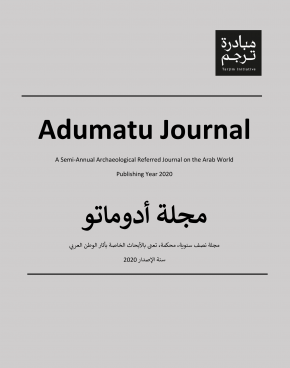
Abstract
Adumatu is a Semi-Annual Archaeological Journal that sheds the light on the archaeological studies of the Arab World. This magazine relies on an academic body of professors in the field of archaeology working in the universities of the Kingdom of Saudi Arabia who oversee the publication of the magazine. In addition, the magazine has an advisory body made up of renowned local and international academic experts in the fields of archaeology, history and social sciences, all of whom have collaborated together to publish more than 41 publications up until the year 2020 AD. In its 2020 volume, issue 41 & 42, the journal covers many titles related to the archaeological and cultural sites sector in the Kingdom of Saudi Arabia; the cradle of Arab and Islamic civilization as well in other countries such Algeria, Libya, Egypt, Jordan and Yemen. Articles in issue 41 have discussed several interesting topics. In one of the researches, the paper discussed a pioneer research of archaeology in the northern frontiers of Saudi Arabia revealed that the area of Nefud Desert and beyond is one of the homelands of Prehistoric cultures in Arabia. The topic titled “Linguistic and Cultural Connotations of an Inscription from the Mining Mission in Wadi Al-Maghara, Sinai, from the Reign of King Bibi II”, the researchers discuss numerous inscriptions that were found by mining missions scattered in Wadi Al-Maghara area Sinai, Egypt. One of the most important of them was found by the British Museum expedition bearing the name and titles of King “Pepi II” from the 6th Dynasty. Issue 42 covers more archaeological and cultural sites researches such as “Names of High Places in Yemen, Selected Samples from Ḏamār Governorate: A Comparative Lexical Study with Arabic and Semitic Languages. This article includes samples of Place Names in Yemen that have been studied and compared with corresponding words in Arabic and some other Semitic languages to recognize the origins of these Names as a semantic field. In another research, the study aimed to illustrate the impact of Samarra’s stucco styles on the Arab Islamic arts. The researcher found that the decoration of Samarra was influenced by the art of its predecessors of Hellenistic, Byzantine and Sassanid origins and continued in the early Islamic periods, especially in the Umayyad period, and took shape in the Abbasid era until it acquired its distinctive personality in the II Abbasid era. In addition, the issue also include other articles such as “The Architectural Artistic Design Features of the Ancient Lighthouse in Al-Khoms City, in Libya (An Architectural Artistic Study)”, “Early Archaeological Museums in Algeria under the French Occupation (Establishment, Purposes and Management: An Analytical Study)” Looting of antiquities in Jordan: A General Overview, and Examples of written Heritage from the Black Desert, northeastern Jordan.
